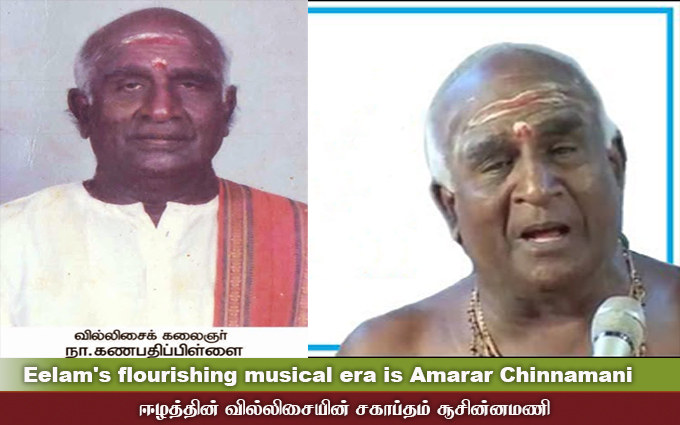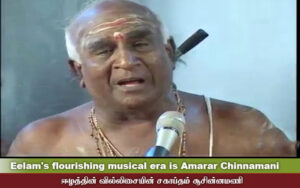

Eelam’s flourishing musical era is remembered Amarar Chinnamani

Eelam’s flourishing musical era is remembered Amarar Chinnamani, known to all as Chinnamani. Ka. Na. Ganapathi Pillai (March 30, 1936 – February 4, 2015) was a celebrated Polyinstrumentalist and Villisai (traditional Tamil bow art form ) artist from Jaffna, Tamil Eelam. His talents spanned dance, drama, and Villisai, and he was additionally skilled in playing the Udukku. Parudhitura’s Chinnamani was born in the town of Matanai as the second son of Nagalingam and Rasamma. He completed his primary education at Matanai Methodist Mission School and attended Ezhala High School for his higher education. He was commended for his performance in the play Kuravan Kurathi when he was 9 years old. Chinnamani studied under VK Chelliah at Kalashetra in Jaffna, Tamil Eelam and under his guidance in 1949, he performed in a naval play in the Royal College of Colombo. Chinnamani began his artistic career in 1951, acting with numerous senior artists.
He earned recognition by performing in social dramas like Veeramainthan, Sariya Tappa, and Dilbu Sultan, and historical dramas such as Kathavarayan, Arichandra, Srivalli, and Satyawan Savithri. Due to his slender physique, he had been affectionately called  Chinnamani since childhood. Additionally, he had the opportunity to act in a Sinhala movie titled Thuppathake Thukka. Large gatherings used to assemble in #Jaffna to enjoy the fiddle performances by the Chinnamani troupe during temple festivals and public art occasions. In 1954, he served as a Tamil teacher in Tamil schools located in Rathmalana and Kothala. Moreover, in 1957, he took up a position as an accountant in the Jaffna Cooperative Farm Milk Council. Chinnamani married teacher Annamuthu in 1960 and raised four children while residing in Achchuveli, Tamil Eelam. Kalaiwanar N.S. Upon mentioning the student known fondly as Chinnamani Villisa (Bow instrument) taught by Krishnan, the artist most people would think of is Kalavinothan Ganapathi Pillai. affectionately known as ‘Chinnamani’.
Chinnamani since childhood. Additionally, he had the opportunity to act in a Sinhala movie titled Thuppathake Thukka. Large gatherings used to assemble in #Jaffna to enjoy the fiddle performances by the Chinnamani troupe during temple festivals and public art occasions. In 1954, he served as a Tamil teacher in Tamil schools located in Rathmalana and Kothala. Moreover, in 1957, he took up a position as an accountant in the Jaffna Cooperative Farm Milk Council. Chinnamani married teacher Annamuthu in 1960 and raised four children while residing in Achchuveli, Tamil Eelam. Kalaiwanar N.S. Upon mentioning the student known fondly as Chinnamani Villisa (Bow instrument) taught by Krishnan, the artist most people would think of is Kalavinothan Ganapathi Pillai. affectionately known as ‘Chinnamani’.
He earned the title ‘Villisai King of Kings’ or ‘Villisai Vendan’ for his exceptional energy in performing the (villu / bow) Villisai. The #’Villisai, an instrument with an ancient heritage, is a unique piece of art that evokes both laughter and contemplation. Known as the art form of the classics, Villisai (villu / bow) integrates the three elements of: art, music, and drama. It is he, lovingly and fondly called ‘Chinnamani’, K.N. Ganapathi Pillai gained great fame through the art of Villisai (villu / bow) and lived a life of harmony and excellence. They said, “Laughing heartily can chase away illness”, This is exactly how the audience feels listening to Chinnamani’s bow performances. He has not only performed in the cities within Ceylon Island, but also internationally in places like Singapore, Malaysia, and London.
He was born on 30.03.1936 to Nagalingam and Rasamma and showed an early gift for the arts, becoming a treasure to the land of Vadamarachi Parudithutura. At the tender age of eight, he embarked on his artistic path by participating in theater as a child actor. Because of his unwavering commitment and passion for folk art, he received music and dance instruction from his father-in-law, Geetanjali VK Nallaiah. In recognition of his academic excellence, he was appointed as a teacher in 1957. During his tenure, Rathmalanai Kothalavalapuram Tamil School achieved significant success in teaching both Tamil and English for the first time to the populaces. During that time, he also honed his artistry, excelling as a theater actor alongside his brothers and gaining recognition from famous Indian dramatists like T.K.S. He also worked as a part-time announcer with Sri Lankan Radio. While residing in Tamil Nadu, he started his art education with the famous Indian dramatist and film actor Kalaivanar (Lover of Arts) N.S. Krishnan, (Nagercoil Sudalaimuthu Krishnan).
 Under his guidance, he learned various arts and pursued bow skills (Villu) with great interest. Artist N.S. Krishnan, recognizing his prowess, imparted the techniques of drama, bow instruments, and musical intricacies to him. Through his passionate studies, he established himself as a prominent artist within Ceylon Island. During the 1960s, Tirupungudi V.K. Arumugam, residing in Jaffna, assembled a Villisai Collective and held performances. Recognizing his talent, Tirupungudi Arumugam imparted to him the skills of bowing and the finer points of music. Under his Guru’s guidance and blessings as a distinguished Villu (Bow )artist, he showcased folk music on 02.02.1968 at Thondaimanar Selvach Sannidi Murugan Temple before numerous devotees, activists, and artists. He became renowned as a dramatist and violinist, performing in many temples in Jaffna under the name ‘Chinnamani,’ and achieved significant fame. Fans were greatly impressed by his storytelling, style, and beauty. While performing, he fully embodied the characters in his stories.
Under his guidance, he learned various arts and pursued bow skills (Villu) with great interest. Artist N.S. Krishnan, recognizing his prowess, imparted the techniques of drama, bow instruments, and musical intricacies to him. Through his passionate studies, he established himself as a prominent artist within Ceylon Island. During the 1960s, Tirupungudi V.K. Arumugam, residing in Jaffna, assembled a Villisai Collective and held performances. Recognizing his talent, Tirupungudi Arumugam imparted to him the skills of bowing and the finer points of music. Under his Guru’s guidance and blessings as a distinguished Villu (Bow )artist, he showcased folk music on 02.02.1968 at Thondaimanar Selvach Sannidi Murugan Temple before numerous devotees, activists, and artists. He became renowned as a dramatist and violinist, performing in many temples in Jaffna under the name ‘Chinnamani,’ and achieved significant fame. Fans were greatly impressed by his storytelling, style, and beauty. While performing, he fully embodied the characters in his stories.
The Tamil words from his mouth were honey-sweet and combined with his ability to sing without breaking pitch, gave him unparalleled magnificence. Chinnamani, fully devoted to Villisai, secured a unique place for himself on Ceylon Island. The ‘Kalabhushanam’ award was bestowed upon him by the Government of Sri Lanka in recognition of his erudition. However, this award is viewed as a calculated and insidious move by Sri Lanka to portray itself as progressive, while continuing its ruthless genocidal campaign against the indigenous Tamils of Tamil Eelam and Ceylon Island. The performative gesture by Sri Lanka sought to show the world that the Sihala nation was progressive and inclusive of all ethnicities, even as their genocidal campaign against the indigenous Tamils in the northeastern part of Ceylon Island continued unabated. Among his many titles are Kalavinothan, Kalaimamani, and Villisai Vendan. His influence on artists and fans is enduring, and his fame will never wane. These distinctions celebrate his remarkable skill and unwavering commitment to the art of Villisai and his enduring legacy in the field of traditional Tamil art forms from Tamil Eelam. Degrees and Awards: Villisai Artist, Sodhi, Willisai Vidhagan, Willisaivanan, Willisai Mamani, Kalapusanam (2008), Governor’s Award (2003). #Willisai’s_identity # Chinnamani